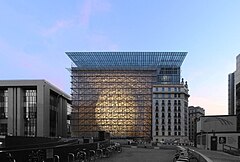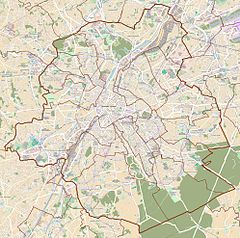Europa building
| Europa building | |
|---|---|
 |
|
| Former names | Résidence Palace - Bloc A |
| General information | |
| Architectural style | Art Deco, Postmodern |
| Location | Brussels, Belgium |
| Address | Rue de la Loi/Wetstraat 155 |
| Coordinates | 50°50′33″N 4°22′51″E / 50.84250°N 4.38083°E |
| Current tenants | Seat of the European Council and Council of the European Union |
| Construction started | 1922 |
| Completed | 1927 |
| Renovated | November 2007 - December 2016 |
| Renovation cost | €321 million |
| Technical details | |
| Floor area | 70 646 m² |
| Design and construction | |
| Architect | Michel Polak |
| Renovating team | |
| Architect |
Philippe Samyn and Partners (architects & engineers, Lead and Design Partner) Studio Valle Progettazioni Buro Happold |
| Other designers | Georges Meurant |
The Europa building is the seat of the European Council and Council of the European Union, located on Wetstraat/Rue de la Loi in the European Quarter of Brussels, the capital city of Belgium. Its defining feature is the multi-storey "lantern-shaped" construct holding the main meeting rooms; a representation of which has been adopted by the both the European Council and Council of the EU as their official emblems. The Europa building is situated on the former site of the partially demolished and renovated Bloc A of the Résidence Palace. Its exterior combines the listed Art Deco façade of the original 1920's building with the post-modern design of architect Philip Samyn. The building is linked via two skyways and a service tunnel to the adjacent Justus Lipsius building, which provides for additional office space, meeting rooms and press facilities.
Following the end of the First World War, Walloon businessman Lucien Kaisin, in collaboration with Swiss architect, Michel Polak, put forward plans for a complex of luxurious apartment blocks for the bourgeoisie and , the Résidence Palace, to be situated on the edge of Brussels' Leopold Quarter. Consisting of five Blocs (A - E), it was to be "a small town within a city" able to provide its residents with onsite facilities, including a theatre hall, a swimming pool, as well as other commercial services such as a restaurants and hairdressers. The Résidence Palace aimed to address the dual shortage of suitable property and domestic workers for the upper classes following the destruction brought about during the war. The foundation stone of the Art Deco building was laid on 30 May 1923 with the first residents moving in 1927.
...
Wikipedia

